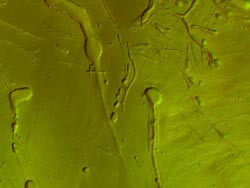Ascraeus Mons in 3D

Image 1: HRSC 3D image of Ascraeus Mons <br>Credits: ESA/DLR/FU Berlin (G. Neukum)
This 3D image shows a portion of the southern flank of Ascraeus Mons, the northernmost volcano of the Tharsis volcano group.
The peculiar depressions which can be observed here, and on several Martian volcanoes, are so-called ’lava tubes’. The anaglyph image has been calculated from the nadir and stereo channels and it was taken by the High Resolution Stereo Camera (HRSC) on Mars Express, from an altitude of 271 kilometres. North is at the right. The 3D image requires stereoscopic (red/green) glasses to view.
This colour image shows a larger portion of the southern flank of Ascraeus Mons. The lighter, ’pink’ areas on the colour image are clouds.
The visible lava tubes are caused by the crusting (or cooled lava) which occurs over a lava channel, a covering making the channel into a tunnel. When lava production ceases, the tunnel empties and the roof of the tunnel falls in, making an elongated depression.
Occasionally, the depression forms a chain of small pits over an emptied lava tunnel. Pit chains and lava tunnels are common on the Martian surface and are also seen on other terrestrial planets and the Moon.
This nadir (vertical view) image is centred at 7.9 degrees North and 255.5 degrees East and was taken by the High Resolution Stereo Camera (HRSC) on Mars Express, from an altitude of 271 kilometres.
This is how the same image looks like before final processing and colour channel addition.
To see the 3D images, you need stereoscopic glasses, readily available in photographic and computer-gaming shops, or via the internet. Be sure to look at your PC screen at arm’s length to appreciate the full three-dimensional effect.
Media Contact
More Information:
http://www.esa.int/SPECIALS/Mars_Express/SEM1NJYV1SD_0.htmlAll latest news from the category: Physics and Astronomy
This area deals with the fundamental laws and building blocks of nature and how they interact, the properties and the behavior of matter, and research into space and time and their structures.
innovations-report provides in-depth reports and articles on subjects such as astrophysics, laser technologies, nuclear, quantum, particle and solid-state physics, nanotechnologies, planetary research and findings (Mars, Venus) and developments related to the Hubble Telescope.
Newest articles

A universal framework for spatial biology
SpatialData is a freely accessible tool to unify and integrate data from different omics technologies accounting for spatial information, which can provide holistic insights into health and disease. Biological processes…

How complex biological processes arise
A $20 million grant from the U.S. National Science Foundation (NSF) will support the establishment and operation of the National Synthesis Center for Emergence in the Molecular and Cellular Sciences (NCEMS) at…

Airborne single-photon lidar system achieves high-resolution 3D imaging
Compact, low-power system opens doors for photon-efficient drone and satellite-based environmental monitoring and mapping. Researchers have developed a compact and lightweight single-photon airborne lidar system that can acquire high-resolution 3D…





















